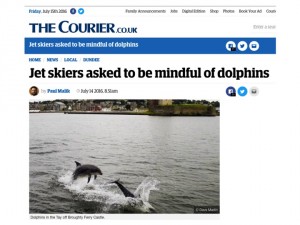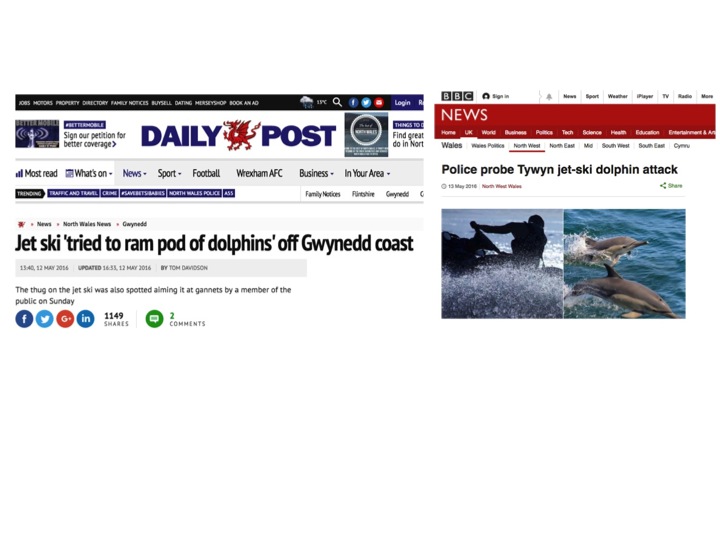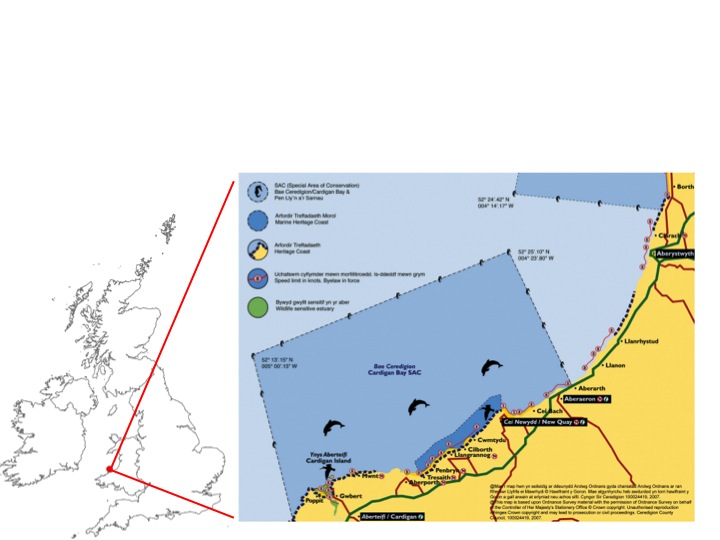With National Whale and Dolphin Watch (NWDW) having just finished, we here at Sea Watch Foundation are seeking to carry this momentum forward by championing that Cetaceans, and the issues they face in an increasingly changeable and hostile world, be given as much coverage on social media (as well as the more traditional news outlets) as is humanly possible.
Cetacean conservation has been in the news very recently via an article by our friends in the Scottish newspaper The Courier, advocating that recreational motorboat and jet-ski users in Tayside and Fife adopt a cautious and mindful approach in how they pilot their vessels when in the presence of marine wildlife.
This article comes hot on the heels of some recent regrettable events, currently under police investigation, closer to home here in Wales, where a jet-skier was seen attempting to ram and potentially cause serious injury to a pod of dolphins.
Forgetting for a moment the intentionally idiotic nature of the behavior seen here, for air breathing mammals like whales, dolphins and porpoises that have to come to the surface occasionally to take a breath, even unintentional boat strikes are a very real and lethal danger. Fast, highly maneuverable vessels present a threat to these animals not only because they may cause a collision, but also because the noise they create from their propellers can be a cause of disorientation, affecting a cetaceans’ ability to navigate, hunt prey and communicate.
This suite of potential perils posed by seagoing vessels is equally shared by our seafaring furry friends in seal communities around the UK.
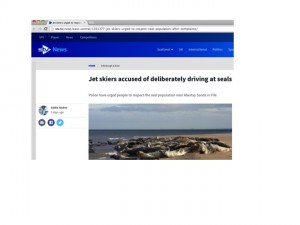 In fact, since beginning to write this post, and serving as a very welcome and informative addendum to the aforementioned article in The Courier, an article with a very similar message (albeit focusing on seals) was featured on ITV’s regional arm in Scotland (STV).
In fact, since beginning to write this post, and serving as a very welcome and informative addendum to the aforementioned article in The Courier, an article with a very similar message (albeit focusing on seals) was featured on ITV’s regional arm in Scotland (STV).
While we can still learn a huge amount from the deceased individuals that we unfortunately occasionally encounter, future challenges in conservation management ultimately depend on live animals and their observation over time. Therefore longitudinal studies, such as the long-term work continually being carried out by us here at Sea Watch Foundation, can help uncover if and how communities, and the individuals within them, are responding to the rapidly changing environment we are experiencing. These observations, based on sound and rigorous scientific data, can then be used to inform conservation management and policy decisions from a local to an international scale, as well as a means to measure the effectiveness (or not) of these decisions.
Thankfully here along the Cardigan Bay coastline, we have two Special Areas of Conservation (SAC’s) as designated under the European Union’s Habitats Directive (92/43/EEC). These are primarily protected areas for our resident Annex II species (Bottlenose dolphins) where their conservation is a priority and where detrimental human activities are kept to an absolute minimum.
With the 1992 UN Rio Earth Summit having put biodiversity firmly on the global political agenda, the European Community produced the Habitats Directive, aimed at putting a halt the loss of biodiversity across the European Union by instructing governments to designate Special Areas of Conservation to protect the continent’s most important wildlife sites. Together with areas designated under the Birds Directive these create a continent-wide network of protected sites, known as the Natura 2000 (N2K) network, of which Cardigan Bay SAC forms a small part.
Southern Cardigan Bay is home to an amazingly rich variety of marine animals and plants, from reef-building worms to the celebrated bottlenose dolphins. The area is home to Europe’s largest population of these iconic animals and there are few places where they are more easily seen in the wild. Cardigan Bay SAC is about more than just dolphins however; its reefs, sandbanks and caves are recognised as being important in their own right, and its population of grey seals and lampreys are also of international importance. The aim of the SAC is to maintain its rich and varied marine life in at least as good a condition as when the site was first designated. This doesn’t mean that we cannot continue to use and enjoy the natural resources of the area, but that any activities have to be carried out sustainably.
The largest bay in Wales, Cardigan bay stretches along the west coast from Strumble Head in Pembrokeshire to Bardsey Island, Gwynedd, and also extending almost 20km from the coast, meaning Cardigan Bay Special Area of Conservation (SAC) protects the wildlife found in around 1000km2 of sea.
From a cetacean-centric viewpoint then, with the areas that they inhabit now being protected, what remains is the complex task of attempting to address human behaviour whilst within these protected areas so we may minimize the potential for harmful vessel strikes and further protect such enigmatic and ecologically important species, while at the same time respecting peoples’ rights to enjoy themselves and their possessions whilst on the water.
Rather than enforcing strict and litigious rules and regulations here, about which some could potentially feel intruded upon and potentially leading to a source of conflict, voluntary codes of conduct have elsewhere proved to be highly effective, and there have been numerous peer-reviewed papers advocating their benefits.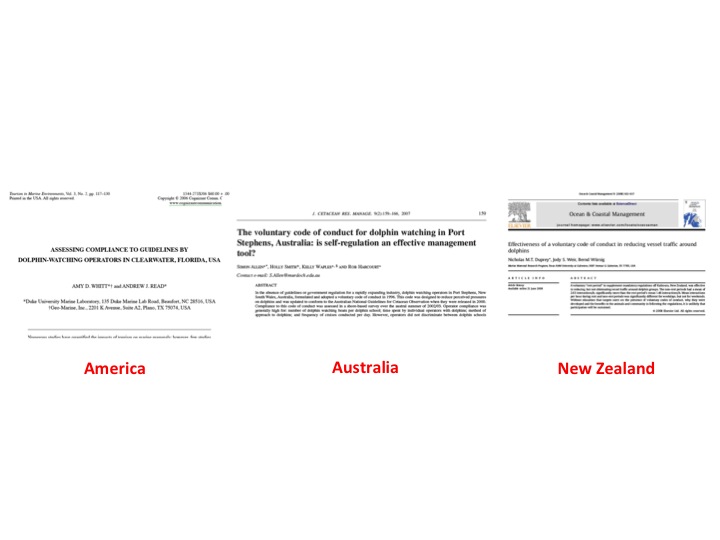
As a cornerstone of its management scheme for the SAC’s then, Ceredigion County Council brought in a voluntary Code of Conduct for marine vessel operators. Members of the general public with an interest in spending a responsible time at sea are encouraged to please read and pick up a leaflet from Ceredigion’s Coastal Tourist Information Centres or download a free copy from http://www.cardiganbaysac.org.uk/wp-content/uploads/2010/04/ceredigion-marine-code-2010.pdf
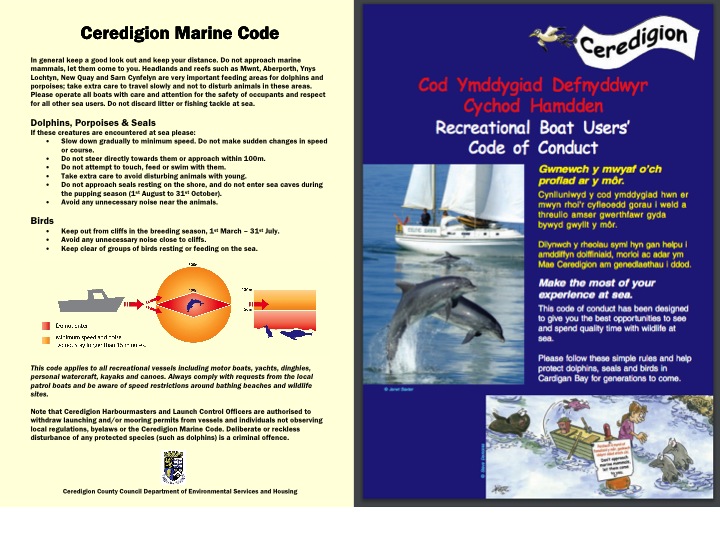 The Code (left hand side above) is basic common sense designed to reduce disturbance to dolphins and porpoise from boating activity. The leaflet also available opens up into a fun cartoon poster (right hand side above) illustrating the main points of the code. Despite the voluntary nature of this code of conduct, it is worth noting that “Deliberate or reckless disturbance of any protected species (such as dolphins) is a criminal offence”. A UK-wide code of conduct can also be found on our website at the following address: http://www.seawatchfoundation.org.uk/marine-code-of-conduct/.
The Code (left hand side above) is basic common sense designed to reduce disturbance to dolphins and porpoise from boating activity. The leaflet also available opens up into a fun cartoon poster (right hand side above) illustrating the main points of the code. Despite the voluntary nature of this code of conduct, it is worth noting that “Deliberate or reckless disturbance of any protected species (such as dolphins) is a criminal offence”. A UK-wide code of conduct can also be found on our website at the following address: http://www.seawatchfoundation.org.uk/marine-code-of-conduct/.
In conclusion then, we here at Sea Watch Foundation whole-heartedly encourage everyone to get out on the sea to share in our love of, and fascination with, all the wonderful marine species that are out there by seeing them first hand in their natural environment. Whether that means going on a tour with one of our recommended boat operators or just going out on your own kayak or motorboat, we encourage everyone to please remember the Marine Code of Conduct and to spare a kind thought for the vulnerable animals that it protects.
By Derry Gibson, SWF Research Intern 2016.

